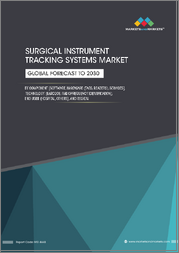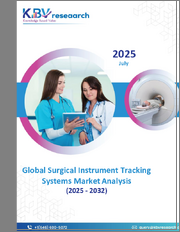
|
시장보고서
상품코드
1609830
일본의 수술 기구 추적 시스템 시장 보고서 : 컴포넌트, 기술, 최종사용자, 지역별(2025-2033년)Japan Surgical Instrument Tracking Systems Market Report by Component, Technology, End User, and Region 2025-2033 |
||||||
일본의 수술 기구 추적 시스템 시장의 시장 규모는 2024년에 860만 달러에 달했습니다. 향후 IMARC Group은 시장이 2033년까지 2,810만 달러에 달하며, 2025-2033년 14.1%의 성장률(CAGR)을 보일 것으로 예측하고 있습니다. 헬스케어 환경에서 환자의 안전성과 업무 효율의 향상에 대한 주목의 증가, 엄격한 규제 준수 요건, 외과적 개입의 증가를 필요로 하는 고령화, 지속적 기술의 진보 등이 시장을 촉진하는 주요 요인입니다.
본 리포트에서 답변하는 주요 질문
- 일본의 수술 기구 추적 시스템 시장은 지금까지 어떻게 추이해 왔으며, 향후 수년간 어떻게 추이하는가?
- COVID-19가 일본의 수술 기구 추적 시스템 시장에 미친 영향은?
- 일본의 수술 기구 추적 시스템 시장의 컴포넌트별 내역은?
- 일본의 수술 기구 추적 시스템 시장의 기술별 내역은?
- 일본의 수술 기구 추적 시스템 시장의 최종사용자별 내역은?
- 일본의 수술 기구 추적 시스템 시장의 밸류체인에는 어떤 단계가 있는가?
- 일본의 수술 기구 추적 시스템에서 주요 촉진요인과 과제는?
- 일본의 수술 기구 추적 시스템 시장의 구조와 주요 기업은?
- 일본의 수술 기구 추적 시스템 시장에서 경쟁의 정도는?
목차
제1장 서문
제2장 조사 범위와 조사 방법
- 조사의 목적
- 이해관계자
- 데이터 소스
- 시장 추정
- 조사 방법
제3장 개요
제4장 일본의 수술 기구 추적 시스템 시장 : 서론
- 개요
- 시장 역학
- 업계 동향
- 경쟁 정보
제5장 일본의 수술 기구 추적 시스템 시장 구도
- 과거 및 현재 시장 동향(2019-2024년)
- 시장 예측(2025-2033)
제6장 일본의 수술 기구 추적 시스템 시장 : 컴포넌트별 내역
- 하드웨어
- 소프트웨어
- 서비스
제7장 일본의 수술 기구 추적 시스템 시장 : 기술별 내역
- 바코드 추적
- 무선 주파수 식별(RFID)
제8장 일본의 수술 기구 추적 시스템 시장 : 최종사용자별 내역
- 병원
- 외래 수술 센터
- 연구 센터
- 기타
제9장 일본의 수술 기구 추적 시스템 시장 : 경쟁 구도
- 개요
- 시장 구조
- 시장 기업 포지셔닝
- 주요 성공 전략
- 경쟁 대시보드
- 기업 평가 상한
제10장 주요 기업의 개요
제11장 일본의 수술 기구 추적 시스템 시장 : 업계 분석
- 촉진요인·억제요인·기회
- Porter's Five Forces 분석
- 밸류체인 분석
제12장 부록
KSA 24.12.24Japan surgical instrument tracking systems market size reached USD 8.6 Million in 2024. Looking forward, IMARC Group expects the market to reach USD 28.1 Million by 2033, exhibiting a growth rate (CAGR) of 14.1% during 2025-2033. The rising focus on enhanced patient safety and operational efficiency in healthcare settings, stringent regulatory compliance requirements, an aging population requiring increased surgical interventions, and ongoing technological advancements represent some of the key factors driving the market.
Surgical instrument tracking systems are crucial tools in the healthcare sector used for monitoring and managing surgical tools and equipment throughout their lifecycle. These advanced systems utilize technologies, such as barcoding, radio-frequency identification (RFID), and real-time location systems (RTLS), to accurately trace the movement, usage, and location of surgical instruments within a medical facility. They facilitate the effective tracking of each instrument from the time of purchase and sterilization to its deployment in surgical procedures and subsequent maintenance. They help enhance patient safety by ensuring that all surgical instruments are properly sterilized and accounted for. They also assist healthcare providers in complying with stringent regulatory requirements, such as those mandated by the Food and Drug Administration (FDA) in the United States. Apart from this, these systems are helping to streamline inventory management, reducing costs associated with instrument loss or overstocking, thereby ensuring operational efficiency. They are also contributing to data-driven decision-making by providing detailed analytics related to instrument utilization. As a result, surgical instrument tracking systems are modernizing the way healthcare institutions manage their valuable surgical assets, leading to optimized workflow, lower overhead, and enhanced patient care.
Japan Surgical Instrument Tracking Systems Market Trends:
The Japan surgical instrument tracking systems market is currently experiencing significant growth, propelled by a combination of factors. One of the primary drivers is the increasing focus on patient safety and surgical efficiency within the healthcare system across the country. Surgical instrument tracking systems are instrumental in reducing the risk of surgical site infections by ensuring the sterilization and proper maintenance of surgical tools. This aligns well with Japan's healthcare policies aimed at enhancing patient outcomes. Additionally, the strict regulatory landscape in Japan represents another major growth-inducing factor. The Pharmaceuticals and Medical Devices Agency (PMDA), along with the Ministry of Health, Labour and Welfare (MHLW), have guidelines that mandate traceability and accountability of medical devices, including surgical instruments. This has necessitated the adoption of tracking systems to maintain compliance, thus fueling market growth. Furthermore, continuous technological advancements, such as the integration of RFID and barcode technology into surgical instrument tracking systems that offer greater accuracy and real-time monitoring capabilities, are making these systems increasingly indispensable in modern healthcare settings, thereby contributing to market growth. As Japan is a technologically advanced nation, the adoption rate of such innovative solutions is naturally high. Along with this, Japan's aging population is further driving the market toward growth as the older demographic typically requires more surgical interventions, leading to a rise in the number of surgeries performed and, consequently, the number of surgical instruments that need to be tracked. This, in turn, has catalyzed the demand for efficient tracking systems, making it a crucial element in healthcare infrastructure improvements. Besides this, surgical instrument tracking systems help hospitals and healthcare providers avoid unnecessary expenditures on overstocking or replacing lost instruments by aiding in precise inventory management. Consequently, a heightened emphasis on cost efficiency is supporting market growth. Moreover, data analytics features offered by these systems aid in better decision-making processes for healthcare providers, optimizing workflow and enhancing operational efficiency, further providing a positive thrust to the market growth.
Japan Surgical Instrument Tracking Systems Market Segmentation:
Component Insights:
- Hardware
- Software
- Services
Technology Insights:
- Barcode Tracking
- Radio Frequency Identification (RFID)
End User Insights:
- Hospitals
- Ambulatory Surgical Centers
- Research Centers
- Others
Competitive Landscape:
The market research report has also provided a comprehensive analysis of the competitive landscape in the market. Competitive analysis such as market structure, key player positioning, top winning strategies, competitive dashboard, and company evaluation quadrant has been covered in the report. Also, detailed profiles of all major companies have been provided.
Key Questions Answered in This Report:
- How has the Japan surgical instrument tracking systems market performed so far and how will it perform in the coming years?
- What has been the impact of COVID-19 on the Japan surgical instrument tracking systems market?
- What is the breakup of the Japan surgical instrument tracking systems market on the basis of component?
- What is the breakup of the Japan surgical instrument tracking systems market on the basis of technology?
- What is the breakup of the Japan surgical instrument tracking systems market on the basis of end user?
- What are the various stages in the value chain of the Japan surgical instrument tracking systems market?
- What are the key driving factors and challenges in the Japan surgical instrument tracking systems?
- What is the structure of the Japan surgical instrument tracking systems market and who are the key players?
- What is the degree of competition in the Japan surgical instrument tracking systems market?
Table of Contents
1 Preface
2 Scope and Methodology
- 2.1 Objectives of the Study
- 2.2 Stakeholders
- 2.3 Data Sources
- 2.3.1 Primary Sources
- 2.3.2 Secondary Sources
- 2.4 Market Estimation
- 2.4.1 Bottom-Up Approach
- 2.4.2 Top-Down Approach
- 2.5 Forecasting Methodology
3 Executive Summary
4 Japan Surgical Instrument Tracking Systems Market - Introduction
- 4.1 Overview
- 4.2 Market Dynamics
- 4.3 Industry Trends
- 4.4 Competitive Intelligence
5 Japan Surgical Instrument Tracking Systems Market Landscape
- 5.1 Historical and Current Market Trends (2019-2024)
- 5.2 Market Forecast (2025-2033)
6 Japan Surgical Instrument Tracking Systems Market - Breakup by Component
- 6.1 Hardware
- 6.1.1 Overview
- 6.1.2 Historical and Current Market Trends (2019-2024)
- 6.1.3 Market Forecast (2025-2033)
- 6.2 Software
- 6.2.1 Overview
- 6.2.2 Historical and Current Market Trends (2019-2024)
- 6.2.3 Market Forecast (2025-2033)
- 6.3 Services
- 6.3.1 Overview
- 6.3.2 Historical and Current Market Trends (2019-2024)
- 6.3.3 Market Forecast (2025-2033)
7 Japan Surgical Instrument Tracking Systems Market - Breakup by Technology
- 7.1 Barcode Tracking
- 7.1.1 Overview
- 7.1.2 Historical and Current Market Trends (2019-2024)
- 7.1.3 Market Forecast (2025-2033)
- 7.2 Radio Frequency Identification (RFID)
- 7.2.1 Overview
- 7.2.2 Historical and Current Market Trends (2019-2024)
- 7.2.3 Market Forecast (2025-2033)
8 Japan Surgical Instrument Tracking Systems Market - Breakup by End User
- 8.1 Hospitals
- 8.1.1 Overview
- 8.1.2 Historical and Current Market Trends (2019-2024)
- 8.1.3 Market Forecast (2025-2033)
- 8.2 Ambulatory Surgical Centers
- 8.2.1 Overview
- 8.2.2 Historical and Current Market Trends (2019-2024)
- 8.2.3 Market Forecast (2025-2033)
- 8.3 Research Centers
- 8.3.1 Overview
- 8.3.2 Historical and Current Market Trends (2019-2024)
- 8.3.3 Market Forecast (2025-2033)
- 8.4 Others
- 8.4.1 Historical and Current Market Trends (2019-2024)
- 8.4.2 Market Forecast (2025-2033)
9 Japan Surgical Instrument Tracking Systems Market - Competitive Landscape
- 9.1 Overview
- 9.2 Market Structure
- 9.3 Market Player Positioning
- 9.4 Top Winning Strategies
- 9.5 Competitive Dashboard
- 9.6 Company Evaluation Quadrant
10 Profiles of Key Players
- 10.1 Company A
- 10.1.1 Business Overview
- 10.1.2 Product Portfolio
- 10.1.3 Business Strategies
- 10.1.4 SWOT Analysis
- 10.1.5 Major News and Events
- 10.2 Company B
- 10.2.1 Business Overview
- 10.2.2 Product Portfolio
- 10.2.3 Business Strategies
- 10.2.4 SWOT Analysis
- 10.2.5 Major News and Events
- 10.3 Company C
- 10.3.1 Business Overview
- 10.3.2 Product Portfolio
- 10.3.3 Business Strategies
- 10.3.4 SWOT Analysis
- 10.3.5 Major News and Events
- 10.4 Company D
- 10.4.1 Business Overview
- 10.4.2 Product Portfolio
- 10.4.3 Business Strategies
- 10.4.4 SWOT Analysis
- 10.4.5 Major News and Events
- 10.5 Company E
- 10.5.1 Business Overview
- 10.5.2 Product Portfolio
- 10.5.3 Business Strategies
- 10.5.4 SWOT Analysis
- 10.5.5 Major News and Events
11 Japan Surgical Instrument Tracking Systems Market - Industry Analysis
- 11.1 Drivers, Restraints, and Opportunities
- 11.1.1 Overview
- 11.1.2 Drivers
- 11.1.3 Restraints
- 11.1.4 Opportunities
- 11.2 Porters Five Forces Analysis
- 11.2.1 Overview
- 11.2.2 Bargaining Power of Buyers
- 11.2.3 Bargaining Power of Suppliers
- 11.2.4 Degree of Competition
- 11.2.5 Threat of New Entrants
- 11.2.6 Threat of Substitutes
- 11.3 Value Chain Analysis



















